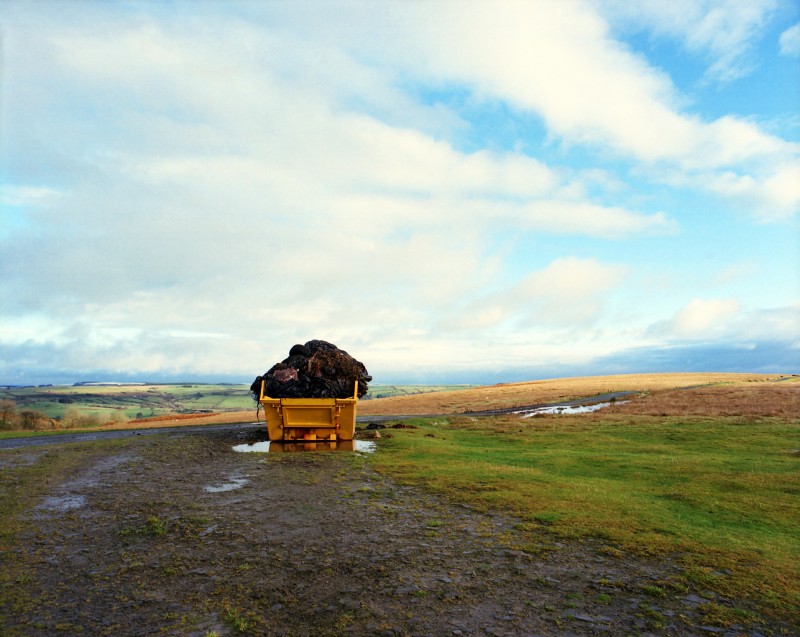My engagement with the ideas and practices of fieldwork stems from my interest in anthropology and the classification of human “types” through the “science” of anthropometry in the mid-nineteenth century, which began when I was a photography undergraduate student. “Field Work” (2010) was my attempt to address visual ethnographic practice from the position of a contemporary photographic practitioner. As a photographer I have always been concerned with issues around race, identity, and representation, and the award of the AOA1 commission provided the opportunity to question specific perceptions of boundaries and region in the United Kingdom, and how these relate to identification with a particular community. The commissioners wanted “an image-maker who can have agency as a British citizen, meditate and reflect on being a ‘stranger,’ but also move to a place that can be seen as his home domain and look out towards ‘his’ England.”
I felt it was essential that I worked in and among the communities where my project would be exhibited; I explicitly wanted to develop relationships with the informants I would question and picture. The ethnographic intent was to create a series of photo-documents in two specific sites—the village of Sway in the New Forest, and Newtown in mid-Wales—but as the project developed I also began to use the video camera as a means to gather firsthand information and to re-imagine the body of the mythical “stranger”2 who ventures into an unknown place. I wanted to deliberately confront the landscape with a black male body but also, through positioning myself visibly as the outsider, as the stranger, the protagonist, to somehow “puncture” the social landscape.3
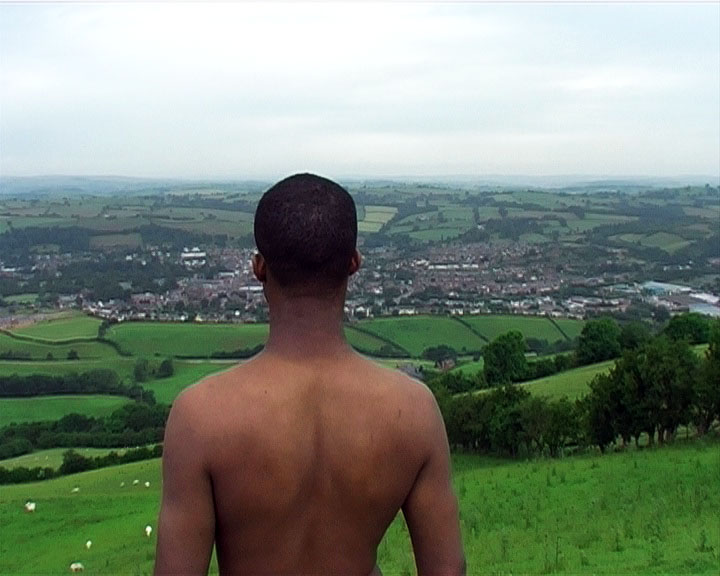
Looking over Newtown (video still from “Field Work”)
In both Sway and Newtown, my immediate response to where I found myself was shock—the phrase “what am I doing here?” is all too accurate. I felt slightly nauseous as the train departed and I made my way to the gallery I was to exhibit in, lugging clothes and equipment to meet a curator and the person who would act as my liaison with the “locals.”4 The locals wanted to impart their ideas about “place” from their own particular points of view, and I faced issues about how to communicate the competing stories about place. A mother and daughter’s views on the rise in house prices because of incoming wealthy outsiders differed greatly in perception from those who saw a calm and settled place—albeit with social issues such as alcohol and drug use “like anywhere else.” And there were issues around race (only on a few occasions openly hostile) where my presence led to discussions about the subtle and complex nature of racism, for example, selling black-faced Golly dolls in local tourist shops. While the informants were happy to talk to me on camera in the moment, they later called to say that they did not want to see their interview broadcast in any form. My experience recording these responses validated the notion that “ethnography’s stories of place and places are increasingly about contestation” (Basso and Feld 1999: 5). Who has the power to define “the community” is something continually in flux.
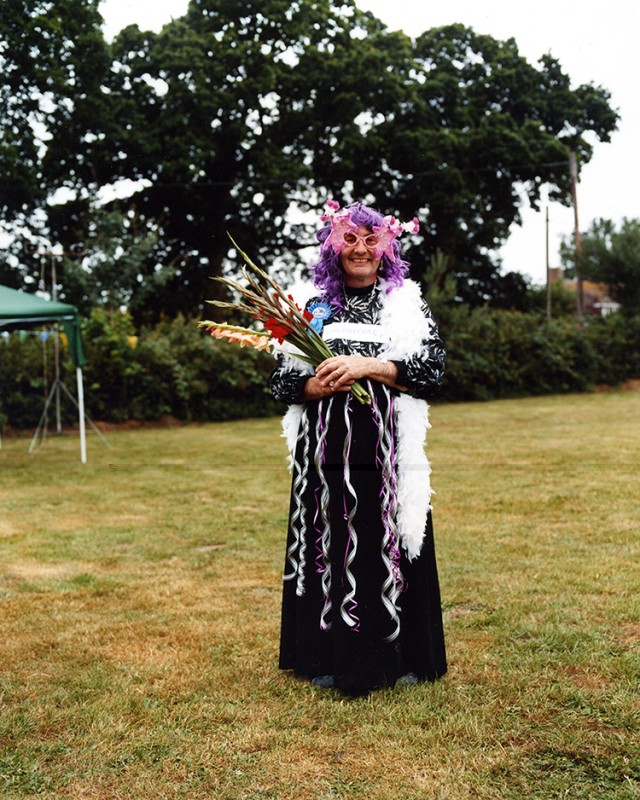
Leader of the New Forest District Council, Councilor Barry Rickman
With more knowledge about ethnographic research practices, I would perhaps have written up the many conversations that I had with individuals’ from both Sway and Newtown. This would have helped me make greater sense of the project and reflect upon my own and others’ actions, contextualizing my practice. Crucially, it might have changed the emphasis of my photography: fewer portraits with the subject posing for the camera, and instead closer, more intimate images within home environments. At the time, I did not consider the project required any written element. As Chin says of the dancer and anthropologist Katherine Dunham’s ethnographic technique, “Dunham implicitly forwarded the idea that ethnography need not be written to do its work” (2011: 41).
I was stubbornly, resolutely, not an anthropologist. From my early interviews there seems a palpable aggression toward the discipline and the academic investment in writing texts about the “colonial subject” (see Schneider and Wright 2006: 125–130), and my early attempts to challenge this position involved visualizing the connection between the “history of anthropology” and the contemporary black subject, through reference to the archive.5 The connection I now see between my early photographic practice and “Field Work” is one in which the subject lying beneath the portrait of famous anthropologist A.C. Haddon (below) could be the one walking in the communities of Sway and Newtown.
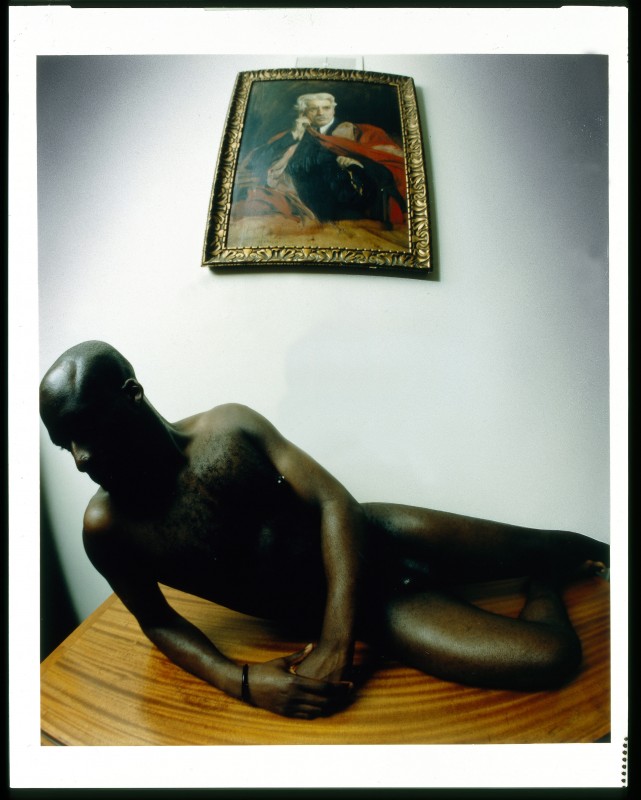
“UNTITLED,” Royal Anthropological Institute of Great Britain and Northern Ireland, 1995
I made the decision to film myself within the “alien landscape.” This forced me to reflect on my presence both as an observer and as an influence on the subjects’ reactions and responses. I wanted to suggest contemporary lines of connection between the practices of ethnography and photography—the processes of gathering firsthand evidence, similar methods of investigation and intent, mining the image for data or visual evidence. Edwards supports this and argues that “while the results may not be ‘anthropological’ in terms of a fully informed and integrated theoretical position, they nonetheless constitute documents of culture or cultural documents whose legitimacy is drawn from the fact that their creators are attempting to communicate values and negotiated realities which are integral to human experience and consciousness” (1997: 54). I hoped my processes and the final work would reveal how these two disciplines can work in a symbiotic way. My photographs of the landscape were attempts to construct images that could be read as data—as Edwards also reminds us, “style in photographic practice within anthropology should explore and communicate, not overwhelm the content in a way that objectifies and fetishises. If expressive visual dialects are to remain relevant within anthropology the transformational qualities of photography should not be over-exploited” (ibid.: 58). Although I did think about more expressive photographic codes, some attempts—such as using blur to impart the idea of movement—seemed to create more of an explicit separation between visualizing data and expression. My intent was to explicitly question the idea of a “photo-document.”
“Field Work” developed through introducing a stranger/outsider (myself) walking within the landscapes—physical and social. Each site was eventually represented by two videos, a “walking” video and an “interview” video, projected together but synchronized so that one screen went dark while the other was visible. In each video in Sway and Newtown, the walking figure’s constant appearing/disappearing pulls the strands of film and photography together. In many ways, the body acts as an allegory for the journeys made within the film’s narrative: a body that acts as a reflective figure for the audience to think about their own understanding(s) of identity, belonging, and community.
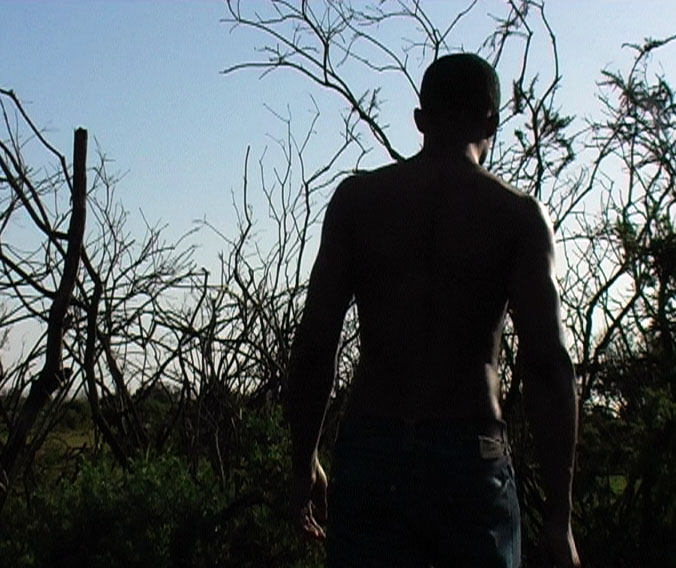
Walking into Sway (video still from “Field Work”)
The range of different voices in “Field Work” attests to an anthropological polyvocality (Caplan 1988) that is mirrored, metaphorically speaking, by the combination of still images (portraits, landscapes) and video (straight interviews, performative actions).6 This allows other perspectives on place to be heard, ones that do not center around the ethnographer’s subjective account. This polyvocality parallels the expanded documentary practice in which those photographed play a visible and productive role in making the work. Caplan states that “the name of the game now is aesthetics, pastiche, collage, juxtaposition, framing, heteroglossia, polyphony/polyvocality, or at the very least, dialogue” (1988: 9). I’d like to think that these concepts are addressed in the exhibition through the juxtaposition of photographs and videos within the space, what Basu calls the “reframing of ethnographic film in reference to ‘articulation’ within an ‘exhibitionary context’” (2008: 104).
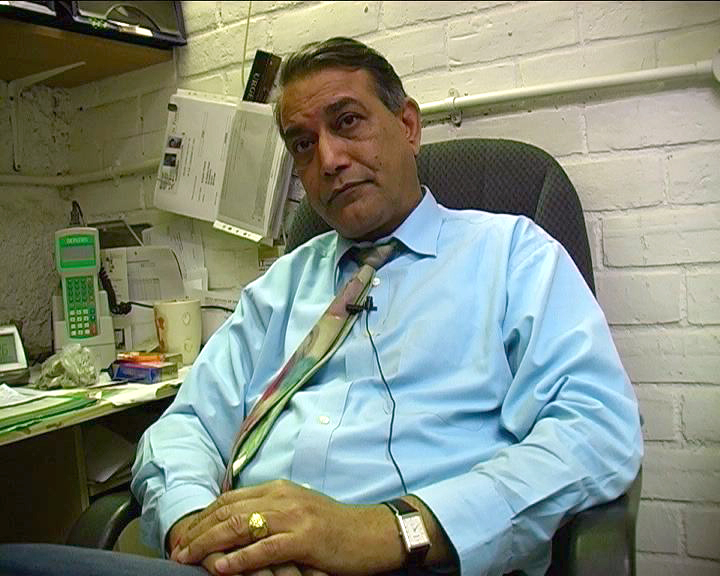
Interview with Pammi (video still from “Field Work”)
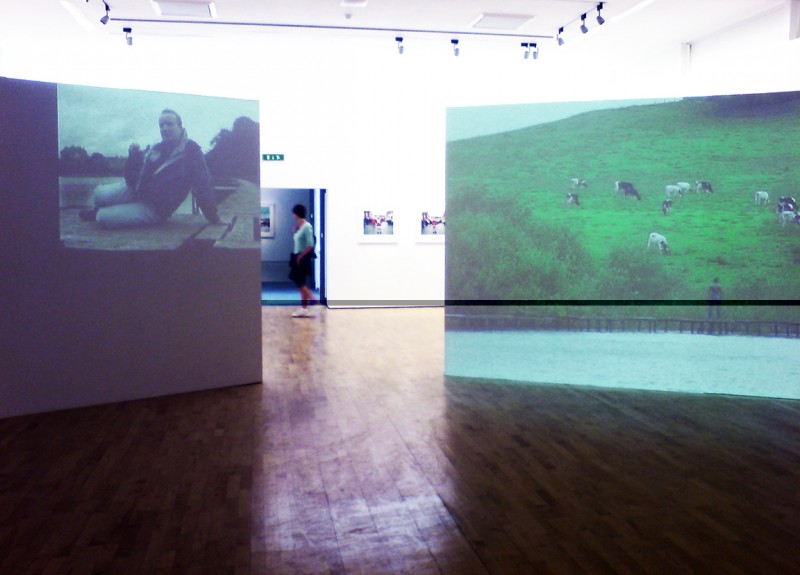
“Field Work” installation at Oriel Davies Gallery, Newtown
Looking back, I understand my responses not just as performance but also possibly as a form of autoethnography (Russell 1999: 276). This was not an intentional objective at the time, but in retrospect it appears that I was both the subject, and the subject of study. This could be criticized as being the “narcissistic confessions of a researcher” (O’Dell and Willim 2011: 9), looking inward toward the producer (myself) rather than outward toward the subject of ethnographic investigation. But in the case of “Field Work,” there is a doubling up of subject/subject of study, photographer/ethnographer, stranger/insider that explicitly questions various positions and roles within anthropology and in terms of the politics of identity and belonging. My practice has deliberately tried to address the torture of the other’s image—an aspect of anthropology’s past—in a new and positive way. This can happen through experimental practices in both disciplines that lead to a more reflexive and inclusive practice. I wanted to show how contemporary photographic practice and visual anthropology could work together outside the archive. Hopefully this suggests a third space where dynamic processes of research and the production of visual imagery can form new types of knowledge.
Dave Lewis is a photographer and lecturer. His work has been exhibited internationally, and he currently teaches visual anthropology courses at Goldsmiths, University of London, and digital photography courses at London South Bank University.
All images in this post are credited to the author.
Notes
1. AOA: Autograph ABP, London; Oriel Davies, Powys, Wales; ArtSway, Sway, New Forest (now defunct)
2. The “stranger” wandering into town is a consistent motif throughout all many genres of film, literature, music, etc. When the stranger arrives, something or someone is usually displaced and/or threatened.
3. See also Ingrid Pollard’s era-defining photographs “Pastoral Interludes” (1987), a series of tinted photographs that meditate on black people’s experiences in the British countryside, challenging the stereotypical notions of black people living solely in urban environments.
4. A scene perhaps reminiscent of Malinowski’s (1922) description of his landing in the Trobroand Islands. Perhaps all ethnographers and photographers share that feeling the first time they arrive at their fieldwork sites.
5. See the exhibitions “The Impossible Science of Being” (1995) and “In Visible Light” (1997).
6. I also made sound recordings of informants who expressly did not want to be visually identified.
References
Basu, Paul. 2008. Reframing ethnographic film. In Thomas Austin and Wilma de Jong, eds., Rethinking documentary, pp. 95–107. Maidenhead, England: Open University Press.
Caplan, Pat. 1988. Engendering knowledge: The politics of ethnography, part 1. Anthropology Today 4(5): 8–12.
Chin, Elizabeth. 2011. Reflections on race, the body and boundaries: How to get on the bus.
Ethnologia Europaea: Journal of European Ethnology 41(1): 43–52.
Edwards, Elizabeth. 1997. Beyond the boundary: A consideration of the expressive in photography and anthropology. In Marcus Banks and Howard Morphy, eds., Rethinking visual anthropology, pp. 53–80. New Haven and London: Yale University Press.
Feld, Steven, and Keith H. Basso, eds. 1999. Senses of place. Sante Fe: School of American Research Press.
Lewis, David. 2010. “Field work.” Edited video. www.vidaimage.co.uk/portal/Field_Work_Extract.html.
Lewis, David. 2012. “Dave Lewis in conversation with Peter Bonnell.” Filmed February and March 2010. Vimeo video. Posted by “ArtSway.” https://vimeo.com/44444408 (accessed 2 June 2015).
Malinowski, Bronislaw. 1922. Argonauts of the Western Pacific: An account of native enterprise and adventure in the archipelagoes of Melanesian New Guinea. London: Routledge & Kegan Paul.
O’Dell, Tom and Robert Willim. 2011. Irregular ethnographies: An introduction. Ethnologia Europaea: Journal of European Ethnology 41(1): pp. 5–13
Pollard, Ingrid. 1988. Pastoral interlude. Photography series. www.ingridpollard.com/pastoral-interlude.html (accessed 2 June 2015).
Russell, Catherine. 1999. Experimental ethnography: The work of film in the age of video. Durham and London: Duke University Press.
Schneider, Arnd, and Christopher Wright, eds., 2006. Contemporary art and anthropology. Oxford and New York: Berg.
Cite as: Lewis, Dave. 2015. “‘Field Work,'” FocaalBlog, 3 August, www.focaalblog.com/2015/08/03/dave-lewis-field-work.
